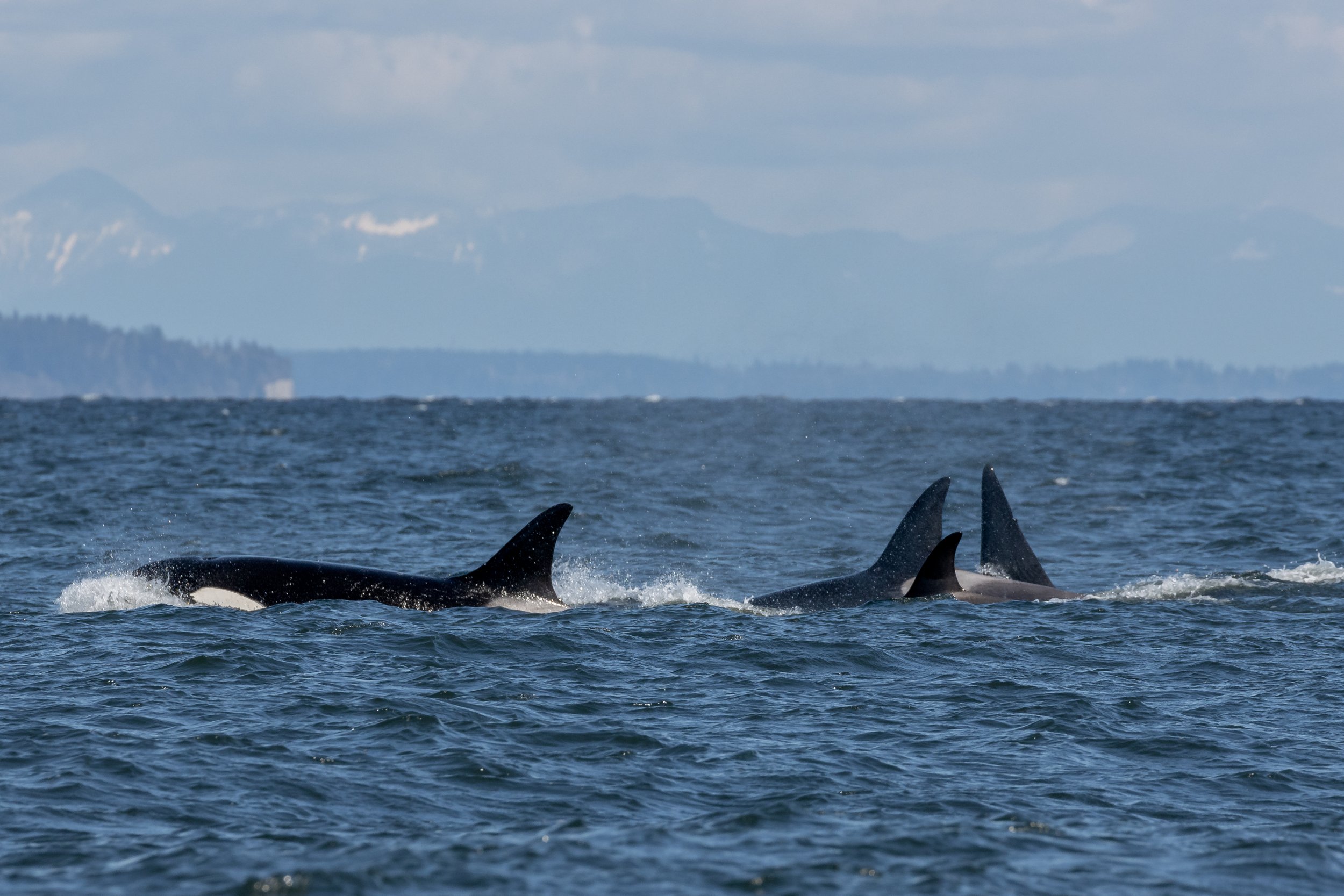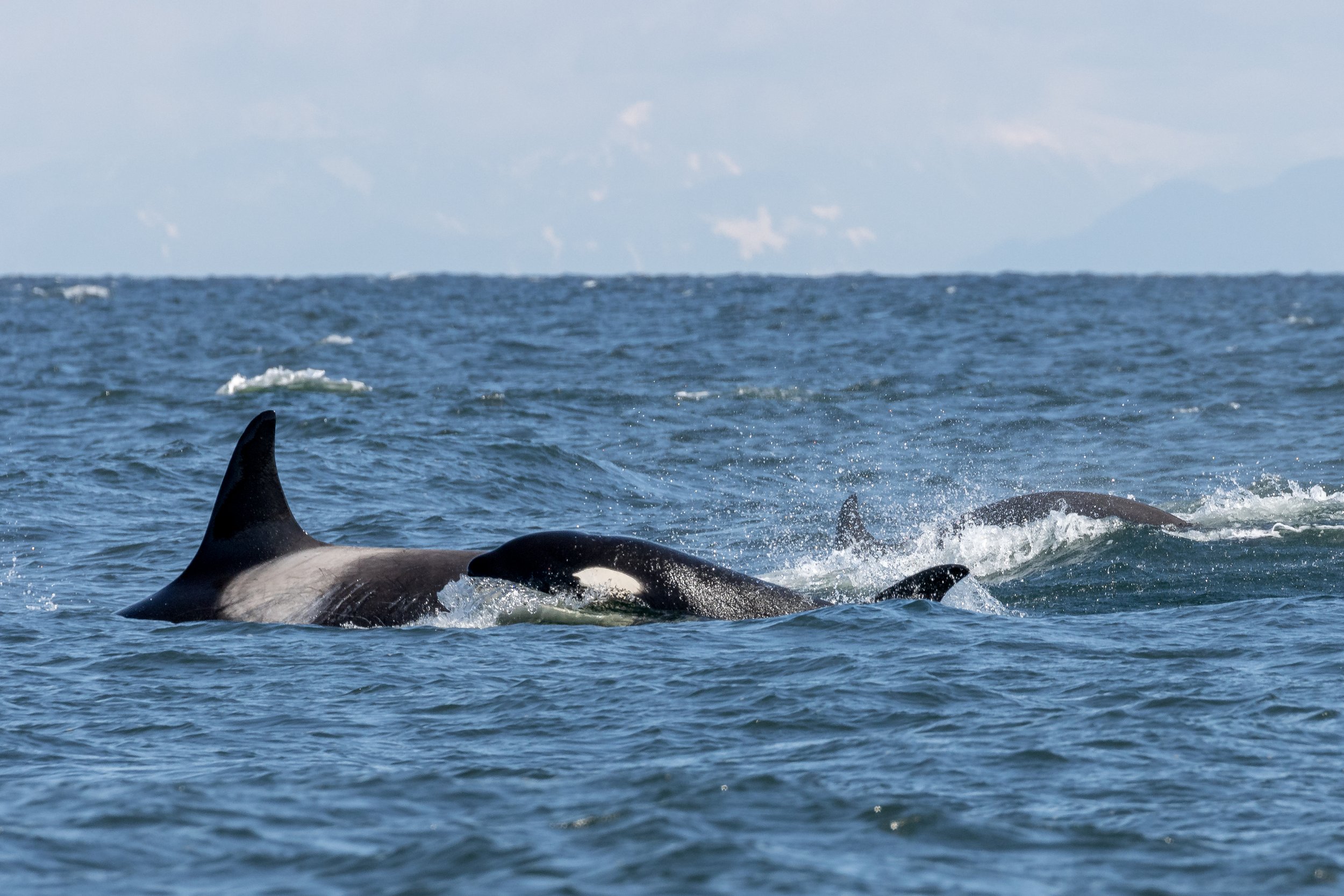April 12, 2023 - The T049As (-A2), T124As and T124C in Active Pass!
It was another beautiful day as our semi-covered vessel, Kula, left the Nanaimo Harbour in search of whales. They headed south, into the Southern Gulf Islands and started their search. First, they headed through one of our favourite places, Dodd Narrows, which is a very narrow opening between Mudge Island and Vancouver Island that is only about 800m wide! Although not very wide, this channel is relatively deep, at around 20m.
Dodd Narrows houses a huge variety of sea life since it created high currents during the tidal changes. When the full current is running it can reach around 10 knots, or 18km/h. These currents help to mix the water, with upwelling bringing cold deep water to the surface, and whirlpools pulling the surface waters to the depths. This mixing makes this a high oxygen area and you find unique sea life here such as surf anemones, gooseneck barnacles, and corals which are typically only found on the west coast of Vancouver Island, since the open surf there mixes the water and introduces oxygen in the same way the currents in Dodd do.
Not only are there lots of interesting invertebrates here, but we also get larger creatures using this area to travel through or for hunting. Playful seals and sea lions are a common sight in the narrows, as they like to play in the current, as well as take advantage of the currents discombobulating the local fish! we can also see larger mammals like Orca, Humpback Whales, and Gray Whales travelling through here, as it’s one of the only passageways between the enclosed waters of the Southern Gulf Islands to the open waters of the Strait of Georgia.
Today there weren’t any whales using Dodd Narrows so we continued south. It wasn’t long before we got word that there was a pod of orca spotted by a ferry near Active Pass, so we headed in that direction in hopes of picking them up! We travelled through Trincomali Channel, all the way down to the southern tip of Galiano Island where we finally found our orca. We were greeted by familiar fins of a family of orca we have been seeing quite often lately, the T049As! Jude still wasn’t travelling with the rest of the family, so it was Nan and her other 5 kids today:
T049A Nan ♀ (1986)
T049A1 Noah ♂ (2001)
T049A3 Nat ♂ (2011)
T049A4 Neptune ♂ (2014)
T049A5 Nebula ♀ (2017)
T049A6 (2022)
Even though they have been making a lot of appearances during our tour over the past month, this doesn’t make it any less exciting for us and for our guests! Similar to Dodd Narrows, Active Pass is also a narrow passageway, this time between Galiano and Mayne Islands, which can produce strong currents. Getting to see a pod of orca having to work with the currents can be very interesting. Sometimes you will see them having to fight the currents and the extra effort can be visible in their surfacing style when this happens, and other time they swiftly move, propelled by the current going in the same direction of their travels, moving at speeds they usually wouldn’t achieve with that effort of swimming.
While watching the T049As and being enthralled by their patterns, we realized they weren’t the only orca in the area. It seemed that not too far away there was another pod, so our curiosity kicked in and we headed over to see who was there.
This time it was a lone male, T124C Cooper, travelling with his sister and nieces/nephews. This second group consisted of:
T124C Cooper ♂ (1992)
T124A Kittiwake ♀ (1984)
T124A4 Sabio ♀ (2010)
T124A4A (2021)
T124A6 Kasuun ♂ (2016)
T124A7 ♀ (2021)
These bonus whales were further into Active Pass than the T049As were, and were leaving the protected waters and headed out into the more open waters of the Strait of Georgia. Sometimes getting to watch orca in higher waves can be pretty funny, as they will often throw more of their bodies out of the water and seem to be playing in the waves. This playfulness is especially noticeable in the younger whales since they already have to do more dramatic surfaces just to get clear of the water to breathe! After spending some time with the second set of whales it was time to leave and start the journey back to Nanaimo. We had one last stop to make in Active Pass through since there is a seal haul out near the southern mouth of the pass, so we got a great view of the little rock sausages before continuing into Trincomali Channel.
It wasn’t long before we arrived back in the Nanaimo Harbour, still in awe of all the unique wildlife we got to experience today. Our onboard naturalist Cheyenne (Chy) Brewster captured some amazing moments from the tour which can be viewed below.
From left to right: T049A5 Nebula, T049A Nan, T049A6, and T049A4 Nat.
T049A1 Noah with another member about to break the water’s surface.
T124A Kittiwake.
From left to right: T124A Kittiwake, T124A4 Sabio, T124A6 Kasuun, and T124C Cooper.
From left to right: T124A Kittiwake, T124A4 Sabio, T124A6 Kasuun, and T124C Cooper.
T124C Cooper.
From left to right: T124A Kittiwake, T124A4A and T124C Cooper.
From left to right: T124A Kittiwake, T124A6 Kasuun and T124A4A.
From left to right: T124A Kittiwake and T124A6 Kasuun.
T124C Cooper.
From left to right: T124A Kittiwake T124A4A and T124A6 Kasuun.
Making a splash!
Going down.
Sunny spot for a Harbour Seal nap pile!
A Stellar Sea Lion nap pile.
A branded Stellar Sea Lion.
Loading up at the Harmac mill.
A large male Stellar Sea Lion doing some people watching!


















